Ever been captivated by the sweeping orchestral sounds of Disney’s Fantasia and wondered about the man who brought them to life? This isn’t your typical dry biography; it’s a journey into the heart and mind of Leopold Stokowski, the enigmatic conductor who defied convention and redefined orchestral music. For more on influential figures, see Elizabeth’s Legacy. We’ll explore his formative years, dissecting the influences that shaped his unique style—his family, his education, and the cultural tapestry of his early experiences. This is about understanding the man behind the music, the iconoclast who challenged norms and sparked both admiration and controversy. Prepare to uncover the real Leopold Stokowski and see how his early life set the stage for a truly revolutionary musical career.
The Genesis of a Maestro: Stokowski’s Formative Years
Leopold Stokowski, born in London on April 18, 1882, embarked on a path less ordinary, ultimately becoming a towering figure in 20th-century music. His parents, Kopernik Joseph Boleslaw Stokowski, a Polish-born cabinet maker, and Annie-Marion (née Moore), of Irish descent, provided a culturally rich, if perhaps not traditionally musical, home environment. That early exposure to diverse cultural influences would become a hallmark of his career, shaping his artistic vision and his openness to experimentation.
His musical journey began early. By age thirteen, Stokowski was already enrolled at the Royal College of Music, marking him as one of its youngest students. This precocious start provided a foundation in classical music tradition, but it was his later willingness to deviate from these norms that truly set him apart. He served as an organist and choir director at various London churches, including St. Marylebone Parish Church and St. James’s Church, Piccadilly. These experiences honed his understanding of harmony and orchestration, while hinting at his future ambitions beyond the organ loft.
Surprisingly, Stokowski’s academic pursuits extended beyond music. He attended The Queen’s College, Oxford, earning a Bachelor of Music degree in 1903. This broader education likely informed his intellectual curiosity and his ability to connect music to larger cultural and philosophical themes, something that would characterize his approach to conducting.
A Conductor Emerges: Style and Early Innovations
The early 1900s marked a critical turning point. Stokowski shifted his focus to conducting, quickly developing a signature style characterized by its expressiveness and dynamism. Eschewing the traditional baton in favor of his hands, he crafted a fluid, almost balletic style that mesmerized audiences. His movements were not mere gestures; they were an extension of the music itself, conveying emotion and shaping the sonic landscape with unparalleled intensity.
Beyond mere style, Stokowski possessed a profound understanding of orchestral timbre and texture. He experimented with unconventional seating arrangements, strategically positioning instruments to create unique sonic blends and highlight specific tonal qualities. This wasn’t about visual spectacle; it was about sonic innovation, a quest to unlock the full potential of the orchestra as a sound-producing machine.
His American debut as the conductor of the Cincinnati Symphony Orchestra in 1909 was a resounding success. He introduced “pops concerts” designed to broaden the appeal of orchestral music. He fearlessly championed contemporary composers, a commitment that would remain throughout his career. Elgar, Sibelius, Rachmaninoff, Debussy, and Stravinsky all found a champion in Stokowski, whose advocacy helped introduce their works to American audiences.
Stokowski’s Legacy: A Pioneer Remembered
Leopold Stokowski’s early life was more than just a prelude to his later fame; it was the crucible in which his unique musical vision was forged. His diverse background, his rigorous training, and his relentless experimentation combined to create a conductor who would forever alter the landscape of orchestral music. His legacy continues to inspire debate and admiration. He remains a potent reminder that true innovation requires not only talent and skill, but also a willingness to challenge convention and embrace the unknown.
Unveiling Stokowski’s Influence: Shaping the Sound of Modern Orchestras
The story of Leopold Stokowski is a testament to the transformative power of early influences and unwavering dedication. His journey from London choirboy to world-renowned conductor is not merely a biography; it’s a case study in artistic innovation and the courage to defy tradition. How did this man, shaped by such diverse experiences, revolutionize the way orchestras sound and the way we experience orchestral music?
From Church Organ to Orchestral Stage: The Seeds of Innovation
Stokowski’s early experiences as a church organist and choir director provided him with a deep understanding of harmony, counterpoint, and the power of sonic architecture. He honed his skills in manipulating sound to create emotional impact. Yet, it was his innate curiosity and his willingness to challenge established norms that truly fueled his innovative spirit. He sought to break free from the rigid constraints of tradition and explore new sonic possibilities.
This spirit of experimentation manifested itself in numerous ways. He challenged conventional seating arrangements, re-positioning instruments to maximize tonal clarity and create unique sonic textures. He experimented with microphone placement, recognizing the potential of recording technology to reshape the listening experience. And, most famously, he abandoned the traditional baton, developing a fluid, expressive conducting style that emphasized physical connection with the music.
The “Stokowski Sound”: A Revolution in Orchestral Performance
What exactly was the “Stokowski Sound”? It was more than just a specific sonic signature; it was a holistic approach to orchestral performance that emphasized clarity, warmth, and emotional impact. He encouraged “free bowing” from the string section, allowing for greater expressiveness and dynamic range. He promoted “free breathing” from the brass section, creating a richer, more resonant sound. And he meticulously sculpted the acoustics of the concert hall, seeking to optimize the listening experience for the audience.
His influence extended far beyond the concert hall. He embraced recording technology, becoming a pioneer in the art of orchestral recording. He understood the power of the microphone to capture the nuances of orchestral sound. He used recording techniques to create a new level of intimacy and immediacy in the listening experience.
He championed contemporary composers, introducing new works to audiences and expanding the orchestral repertoire. He was a tireless advocate for music education, believing that everyone should have access to the transformative power of music.
The Enduring Legacy: Stokowski’s Impact on Modern Orchestras
Leopold Stokowski’s influence continues to resonate in the world of orchestral music. His innovative techniques, his passionate advocacy for contemporary music, and his unwavering commitment to artistic excellence have left an indelible mark on generations of conductors, composers, and musicians. He remains a controversial figure, his unorthodox methods sparking debate and challenging conventional wisdom. Yet, there is no denying his profound impact on the sound of modern orchestras and the way we experience orchestral music.
Key Contributions:
- Revolutionary Seating Arrangements: Stokowski’s unconventional placement of instruments transformed orchestral sound, enhancing tonal clarity and creating unique sonic textures.
- Pioneering Use of Recording Technology: He recognized the potential of recording technology to reshape the listening experience, becoming a master of orchestral recording techniques.
- Champion of Contemporary Composers: Stokowski fearlessly championed new music, expanding the orchestral repertoire and introducing audiences to fresh voices.
- Expressive Conducting Style: His fluid, baton-less conducting style emphasized physical connection with the music, inspiring generations of conductors.
- The “Stokowski Sound”: A holistic approach to orchestral performance characterized by clarity, warmth, and emotional impact.
https://www.britannica.com/biography/Leopold-Stokowski
Beyond the Baton: Leopold Stokowski’s Unconventional Approach and Lasting Impact
Leopold Stokowski’s name conjures images of sweeping gestures, innovative orchestral arrangements, and a relentless pursuit of sonic perfection. But beyond the conductor’s flamboyant persona lies a profound understanding of music and a willingness to challenge established norms. How did his unconventional approach impact the world, and why does he remain a subject of fascination and debate?
Key Aspects:
- Stokowski’s innovative seating arrangements revolutionized orchestral sound.
- His rejection of the baton and adoption of free-hand conducting became his trademark.
- He championed contemporary composers.
- His experiments with recording technology transformed the listening experience.
- He maintained a controversial personality.
Early Influences and Artistic Development
Leopold Stokowski’s journey from London choirboy to orchestral innovator was shaped by a unique blend of formal training and intellectual curiosity. His early musical experiences instilled in him a deep appreciation for the power of sound. He was an exceptional organist, learning how to get the most out of the instrument and create compelling sonic textures. This gave him a strong understanding of harmony and the architecture of composition, which would prove vital to his future ambitions.
This foundation, coupled with his broader academic pursuits at Oxford University, fueled a spirit of intellectual inquiry that would define his approach to music. He saw music not as a static art form, but as a dynamic and evolving language capable of expressing the full range of human emotion. He sought to unlock its hidden potential through innovation and experimentation.
He wasn’t satisfied with simply replicating the sounds of the past. He sought to create something new, something that reflected the spirit of his time. He embraced contemporary composers, giving their works a prominent platform and introducing them to audiences who might otherwise never have heard them.
His belief was that music should be a living art form capable of constant reinvention. This philosophy extended to every aspect of his work, from seating arrangements to conducting techniques to recording practices. Stokowski was not afraid to challenge established norms










